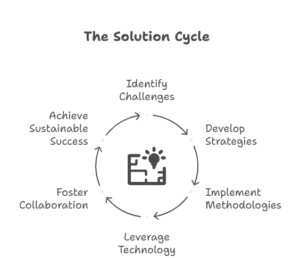Integrating Patient Financial Responsibility into Revenue Cycle Management (RCM) Processes

In today’s healthcare landscape, the financial aspect of patient care is no longer solely in the hands of payers and healthcare providers. Patients are increasingly responsible for a larger portion of their healthcare costs, a trend that is driven by rising insurance premiums, high deductibles, and co-pays. As a result, integrating patient financial responsibility into Revenue Cycle Management (RCM) processes has become crucial for healthcare organizations to ensure financial sustainability, reduce bad debt, and improve patient satisfaction.
Key Takeaways:
Patient Financial Responsibility refers to the portion of medical expenses that patients are required to pay out of pocket.
Integrating this responsibility into RCM helps reduce financial errors and improves patient collections.
Efficient integration ensures accurate billing, transparent communication, and better patient engagement.
Leveraging technology, such as patient portals and financial assistance programs, can ease the process for both patients and providers.
Real-Life Example
Imagine a healthcare provider, Hospital, which has seen a significant rise in patient self-pay balances due to high deductible health plans. In the past, these balances were often overlooked until the final stages of the RCM process, leading to delayed collections and patient dissatisfaction.
ABC Hospital decided to integrate patient financial responsibility into its RCM processes at the very beginning of the patient journey. The front desk staff now verifies insurance coverage and estimates patient costs upfront using automated tools. Additionally, patients are informed about their financial responsibilities through clear communication, including payment options and financial assistance programs.
By integrating financial responsibility early in the process, ABC Hospital has significantly reduced its bad debt, improved collections, and ensured a smoother financial experience for its patients.
The Problem
Traditional RCM processes often fail to address the patient’s financial responsibility until after the service has been provided. This late-stage billing approach can lead to several challenges:
Delayed Payments: Patients may be surprised by their bills, leading to delayed payments or failure to pay altogether.
Increased Bad Debt: Without upfront discussions, patients may not have the resources or understanding to manage their out-of-pocket costs.
Inefficient Use of Resources: Healthcare providers may spend valuable time chasing payments rather than focusing on patient care.
The Solution

The key to solving these challenges lies in integrating patient financial responsibility into RCM processes from the very beginning. Here’s how healthcare organizations can do this effectively:
Patient Financial Responsibility Estimates:
Use automated tools to provide patients with upfront estimates of their financial responsibility, including deductibles, co-pays, and co-insurance. This transparency allows patients to prepare for their expenses.
Clear Communication:
Ensure that all communication about financial responsibility is clear and accessible. This includes providing patients with easy-to-understand billing statements and offering payment plan options.
Front-End Verification:
Integrate insurance verification and eligibility checks early in the process to accurately determine the patient’s financial responsibility. This helps avoid billing errors and reduces the chance of denied claims.
Financial Assistance Programs:
Offering financial assistance programs or connecting patients with third-party financial counselors can help ease the burden on patients, especially those who are unable to pay the full amount.
Use of Patient Portals:
Provide patients with access to online portals where they can track their financial responsibilities, make payments, and set up payment plans.
Results
By integrating patient financial responsibility into the RCM process, healthcare organizations can experience several benefits:
Faster Collections:
By discussing financial responsibilities upfront, providers can collect payments faster, reducing the time it takes to settle accounts.
Reduced Bad Debt:
Clear communication and upfront financial responsibility estimates significantly reduce the amount of unpaid debt.
Improved Patient Satisfaction:
When patients are aware of their financial responsibilities and feel supported by financial assistance programs, they are more likely to have a positive experience with the provider.
More Accurate Billing:
Automating and verifying financial information at the front end reduces billing errors and minimizes denials.
What Did We Learn?
Integrating patient financial responsibility into RCM processes isn’t just about collecting payments; it’s about improving transparency, efficiency, and patient satisfaction. By using automated tools, offering financial assistance, and ensuring clear communication, healthcare providers can successfully manage patient financial responsibility while improving their bottom line.

What People Are Asking?
Why is patient financial responsibility integration important?
It helps reduce delayed payments, bad debt, and billing errors, ensuring timely payments and smoother operations.
How can automated tools help with financial responsibility?
Automated tools can provide upfront cost estimates and verify insurance coverage, helping patients understand their out-of-pocket costs early on.
What are the benefits for patients?
Patients receive transparency about their costs, which helps them plan and reduces the shock of unexpected bills.
How can financial assistance programs be integrated?
Offering programs such as payment plans or connecting patients with financial counseling can ease the financial burden and improve patient satisfaction.
What role do patient portals play?
Patient portals provide easy access to billing information, payment options, and financial assistance, giving patients control over their financial responsibilities.
Disclaimer
For informational purposes only; not applicable to specific situations.
For tailored support and professional services,
please contact Staffingly, Inc. at (800) 489-5877
Email: support@staffingly.com.
About This Blog: This Blog is brought to you by Staffingly, Inc., a trusted name in healthcare outsourcing. The team of skilled healthcare specialists and content creators is dedicated to improving the quality and efficiency of healthcare services. The team passionate about sharing knowledge through insightful articles, blogs, and other educational resources.
 Book a Demo to Build Your Team Today!
Book a Demo to Build Your Team Today!



 Read Case Studies
Read Case Studies 


 Virtual Medical Assistants
Virtual Medical Assistants



